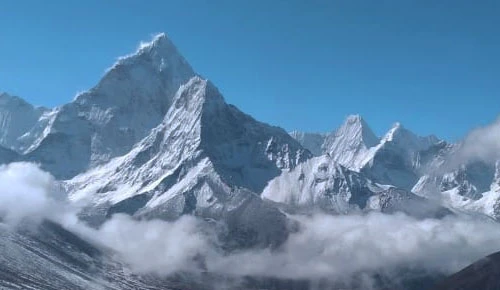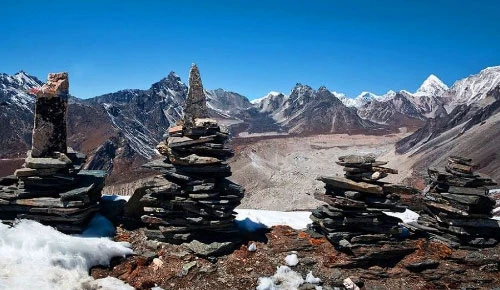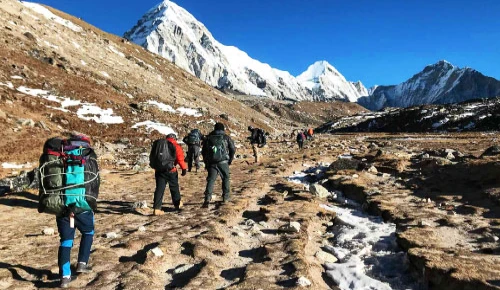Trekkers Information Management Systems (TIMS) Card in Nepal
In Nepal, it is mandatory for all trekkers, regardless of whether they are traveling alone or in a group, to obtain trekking permits before embarking on their mountain adventures. The fees for these permits vary depending on the specific trekking region, and it is essential to ensure that you have obtained the appropriate permits for your intended trek.
To regulate and monitor all trekking destinations, various government bodies and authorized associations, such as the Department of Immigration office, Nepal Tourism Board, Trekking Agencies of Association of Nepal (TAAN), and the National Trust for Nature Conservation (NTNC), issue Nepal Trekking Permits. These organizations play a crucial role in maintaining the safety and security of trekkers and preserving the natural beauty of Nepal's mountains.
Therefore, if you plan to trek in Nepal, it is vital to follow Nepal trekking rules and obtain the necessary permits. Doing so not only ensures a hassle-free and secure trekking experience but also supports the conservation of Nepal's magnificent mountain environment

Table of Contents
Different Types Of Permits
Nepal is home to some of the most spectacular trekking routes in the world, and many of them are located in protected areas where trekking permits are required. It is important to note that these Nepal trekking permit costs are subject to change, and it is always best to check with a local trekking agency or the Nepal Tourism Board for the most up-to-date information on trekking permits. Here are the different categories of trekking permits in Nepal:
Tims Card: Trekkers’ Information Management System
The implementation of the Trekkers' Information Management System (TIMS) Card by the Nepal Tourism Board (NTB) and Trekking Agencies Association of Nepal (TAAN) is a joint initiative aimed at ensuring the safety and security of trekkers while regulating illegal trekking activities in Nepal. As of January 1st, 2008, TIMS Card permits have been issued to all trekkers.
Effective from April 1, 2023, the latest version of the trekking permit, the E-TIMS Card, has been introduced online. However, this permit is exclusively available to group trekkers who utilize the services of government-authorized trekking agencies, and not to free individual trekkers (FITs).
Previously, TIMS permits were issued by the Nepal Tourist Board directly to free individual trekkers through a form available at the Tourism office at Bhrikutimandap. However, the introduction of the E-TIMS Card mandates its use by all trekkers in Nepal, except in restricted areas where trekkers obtain special permits from the Department of Immigration Office.
Note: Only government registered companies and members of the Trekking Agencies Association of Nepal (TAAN) are eligible to obtain the Trekkers' Information Management System (TIMS) card. To acquire the TIMS card through online means, please access the provided E-tims card portal and carefully follow the given instructions.
The E-TIMS Card is a critical tool in ensuring the safety and security of trekkers in Nepal. The implementation of this online system is a progressive move towards efficient and reliable data management for the benefit of all stakeholders. It is expected to enhance the trekking experience and facilitate smooth operations for government agencies and authorized trekking agencies.
The cost of an E-TIMS Card is NPR 2000 per person for international trekkers and NPR 1000 for those from the South Asian Association for Regional Cooperation (SAARC) countries.
Trekking without a guide or TIMS Card on designated trekking trails will result in a fine for any offender.
Documents required for TIMS
To apply for a TIMS (Trekkers' Information Management System) card in Nepal, the following documents are typically required:
- A valid passport (with a minimum of six months' validity remaining)
- A valid visa for Nepal
- Two passport-sized photos
- A completed TIMS application form (which can be obtained from the Nepal Tourism Board office in Kathmandu or from a registered trekking agency)
- Trekking itinerary or details of the trekking route
- Emergency contact details
- Insurance policy document (optional)
It is important to note that the requirements may vary based on the type of TIMS card (individual or group) and the specific trekking route. It is recommended to check with a registered trekking agency or the Nepal Tourism Board for the most up-to-date information.
National Park/Conservation Area Entry Permit
A National Park/Conservation Area Entry Permit is a document that allows visitors to enter and explore the protected areas of Nepal. These areas include national parks, conservation areas, wildlife reserves, and hunting reserves. Nepal is known for its wide variety of plants and animals, and its national parks and conservation areas give visitors a chance to see the country's natural beauty and wildlife.
A National Park/Conservation Area Entry Permit is mandatory for all visitors to these protected areas. The permit can be obtained from the entry points or offices of the respective national parks or conservation areas. The fees for the permit vary depending on the area and the duration of the visit. The permit is valid for a specific period, and visitors must leave the protected area before the permit expires.
These permits play a significant role in protecting the natural resources of Nepal. The funds generated from the permit fees are used for the conservation and management of the protected areas. These areas are home to endangered species, and the permit fees contribute towards their protection and conservation.
The permit also helps regulate the number of visitors to the protected areas. The authorities limit the number of visitors to these areas to prevent overcrowding and minimize the impact of tourism on the environment. By regulating the number of visitors, the authorities can also ensure the safety of visitors and wildlife.
Documents Required for National Park/Conservation Area Entry Permit
To obtain a National Park or Conservation Area Entry Permit in Nepal, you will need to provide the following documents:
- A valid passport with at least six months validity remaining.
- Two passport-sized photographs.
- A completed application form, which can be obtained from the Nepal Tourism Board or the Department of National Parks and Wildlife Conservation.
- Payment for the entry permit fee. This can be done at the permit issuing office or online through the Department of National Parks and Wildlife Conservation's website.
- For trekkers, a valid trekking permit is also required, which can be obtained from the Nepal Tourism Board or the Department of Immigration.
It is important to note that the specific documents required may vary depending on the specific national park or conservation area that you plan to visit, so it is always a good idea to check with the relevant authorities for the most up-to-date information.
Restricted Area Permit (Special Permits)
In Nepal, some trekking areas are classified as "restricted," meaning that they require a special permit for trekkers to access them. These special permits are issued by the Department of Immigration Office and are also known as restricted trekking permits or special permits.
Restricted trekking permits are required for certain trekking routes that are located in remote areas or near sensitive border regions. These areas often have few facilities and are hard to get to, which adds to their appeal for trekkers who want to go somewhere off the beaten path.
Some of the most popular trekking routes that require a restricted trekking permit include Upper Mustang, Upper Dolpo, Kanchenjunga, and Manaslu. These areas are known for their unique cultures, different landscapes, and breathtaking mountain views. This makes them popular with trekkers who want a more adventurous and immersive experience.
he cost of a restricted trekking permit Nepal varies depending on the trekking route and the duration of the trek. The permit fee can range from USD 10 to USD 500 per person per week. Trekkers must also hire a licensed guide and work with a registered trekking agency to set up transportation, lodging, and other logistics.
Documents Required for Restricted Area Permit (Special Permit)
Restricted trekking permits, also known as special permits, are required for certain trekking areas in Nepal that are considered to be remote or restricted. The documents required for obtaining a restricted trekking permit in Nepal may vary depending on the specific trekking area, but generally include the following:
- A valid passport with at least six months of validity from the date of entry into Nepal.
- A valid visa for Nepal. This can be obtained from Nepalese diplomatic missions or consulates abroad, or on arrival at the Tribhuvan International Airport in Kathmandu.
- Two passport-sized photographs.
- An agreement letter, guarantee letter, and tax clearance certificate from the trekking agency.
- A completed trekking permit application form. This can be obtained from the Department of Immigration in Kathmandu or from the local trekking agencies.
- A copy of your travel itinerary, including the dates and locations of your trek.
- A valid trekking permit for the specific area you wish to trek in.
- Proof of payment of the applicable permit fees.
- Proof of registration and a certificate of permanent account number.
- A recommendation letter from a recognized trekking agency in Nepal.
- A copy of your travel insurance policy.
It's important to remember that some restricted areas may require extra permits or paperwork, like a climbing permit for trekking peaks or a special permit for certain areas. It is best to check with the local authorities or a reputable trekking agency for the specific requirements for the area you wish to trek in.
Rural Municipality Trekking Permit
Rural municipalities are responsible for managing and regulating trekking activities within their jurisdiction. As such, a Rural Municipality Trekking Permit is required for trekkers who plan to explore trekking trails within these rural areas.
The Rural Municipality Trekking Permit is a legal document that allows trekkers to enter and trek within the designated rural municipality area. The cost of this permit, which the rural municipality's office issues, varies depending on the particular rural municipality and how long the trek is.
The goal of this permit is to make sure that trekkers are safe and secure while also giving rural municipalities a chance to make money from tourism. The funds generated from these permits are often used to maintain trekking trails, construct basic infrastructure, and promote sustainable tourism in rural areas.
It is important to note that the Rural Municipality Trekking Permit is in addition to the TIMS Card or the E-TIMS Card, which are required for trekking in Nepal. Therefore, trekkers must obtain both permits to be allowed to trek in rural municipalities.
Trekking without a permit is illegal and can result in fines or legal penalties. Also, having the proper permits ensures that trekkers have access to necessary resources such as guides, maps, and emergency services, which can be crucial in case of any unforeseen incidents during the trek.
Documents Required for Rural Municipality Trekking Permit
To obtain a Rural Municipality Trekking Permit in Nepal, you typically need to provide the following documents:
- A valid passport with at least six months of validity left.
- A valid visa for Nepal.
- A Trekker's Information Management System (TIMS) card is required for all trekkers in Nepal. You can obtain this card from the Nepal Tourism Board or from a registered trekking agency.
- A detailed itinerary of your trek, including the dates and locations of your trek.
- A travel insurance policy that covers trekking in Nepal is required.
- Depending on the route you are taking, you may need additional permits such as the Annapurna Conservation Area Permit (ACAP) or the Sagarmatha National Park Permit.
- Two passport-sized photos are required.
- A registered trekking agency in order to obtain the Rural Municipality Trekking Permit.
It's important to note that the specific requirements for the Rural Municipality Trekking Permit may vary depending on the location and season of your trek. It's always a good idea to double-check with the local authorities or a registered trekking agency for the latest information and requirements.
TIMS Trekking Areas, Route and Check Post Counters
Kanchenjunga Region
Trekking Name | Normal Route | TIMS Check Post (Entry Point) | TIMS Check Post (Exit Point) |
1. Kanchenjunga Basecamp via Sele La Pass Trek | Yamphudin – Kanchenjunga South Basecamp - Sele La Pass – Ghunsa – Kanchenjunga Basecamp - Lelep | Yamphudin | Ghunsa |
2. Kanchenjunga Basecamp Trek | Taplejung – Lelep - Ghunsa – Kanchenjunga Basecamp. | Ghunsa
| Ghunsa
|
3.Kanchenjunga Basecamp Nango Pass Trek | Taplejung – Lelep - Ghunsa – Kanchenjunga Basecamp – Nango La Pass – Olangchung Gola - Lelep | Ghunsa
| Olangchung-Gola
|
4. Lumba Sumba Pass Trek | Taplejung – Olangchung Gola – Lumba Sumba Pass - Chyamtang – Num | Olangchung-Gola
| Num
|
Makalu Barun Area
Trekking Name | Normal Route | TIMS Check Post (Entry Point) | TIMS Check Post (Exit Point) |
1. Makalu Basecamp Trek | Tumlingtar – Num - Tashi Gaun – Yangle Kharka – Makalu Basecamp | Num
| Num
|
2. Sherpeni Cole Pass Trek | Tumlingtar – Num - Tashi gaun – Yangle Kharka – Makalu Basecamp - Sherpeni Cole Pass – Chhukung – Namche - Monjo- Lukla | Num
| Monjo
|
Everest Region
Trekking Name | Normal Route | TIMS Check Post (Entry Point) | TIMS Check Post (Exit Point) |
Lukla – Monjo- Namche – Dingboche – Everest Basecamp - Namche | Monjo
| Monjo
| |
2. Gokyo Trek | Lukla – Monjo-Namche – Machhermo – Gokyo - Namche | Monjo
| Monjo
|
Lukla – Monjo- Namche – Machhermo – Gokyo – Chho La Pass – Everest Base camp - Namche | Monjo
| Monjo
| |
4. Gokyo Renjo La Pass Trek | Lukla – Monjo-Namche – Machhermo – Gokyo – Thame - Namche | Monjo
| Monjo
|
Lukla – Monjo-Namche – Dingboche – Khongma La Pass - Everest base camp – Chho La Pass – Gokyo – Thame | Monjo
| Monjo
| |
Lukla – Monjo- Namche – Everest view | Monjo
| Monjo
| |
1. Lukla – Kothe – Khare – Mera Basecamp 2. Lukla – Paiya – Kothe – Khare 3. Bung – Kothe – Khare – Mera Basecamp – Kothe - Lukla | Kothe
| Kothe
| |
Lukla – Kothe – Khare – Seti pokhari – Amphu basecamp –Namche - Monjo-Lukla | Kothe
| Monjo
|
Rolwaling Region
Trekking Name | Normal Route | TIMS Check Post (Entry Point) | TIMS Check Post (Exit Point) |
Charikot – Simigaon – Beding – Na gaun- Tsorolpa | Simigaon
| Simigaon
| |
2. Tashi Labtsha Pass Trek | Charikot – Simigaon – Beding – Na gaun – Tsho Rolpo Lake – Tashi Labtsha Pass - Namche-Monju -Lukla | Simigaon
| Monjo
|
Panchpokhari Bhairabkunda Area
Trekking Name | Normal Route | TIMS Check Post (Entry Point) | TIMS Check Post (Exit Point) |
1. Panch Pokhari Trek | Bhotang – Nosyangpati – Panchpokhari -Bhotang | Bhotang
| Bhotang
|
Helambu Region
Trekking Name | Normal Route | TIMS Check Post (Entry Point) | TIMS Check Post (Exit Point) |
1. Helambu Trek | Kutumgsang – Melamchi gaun – Tarkighyang - Shermathang | Kutumgsang | Tarkeghyang |
Kutumgsang – Thade Pati – Gosaikund – Dhunche | Kutumgsang | Dhunche |
Langtang Region
Trekking Name | Normal Route | TIMS Check Post (Entry Point) | TIMS Check Post (Exit Point) |
Syabrubesi – Langtang – Kyanjin - Syabrubesi | Syabrubesi
| Dhunche
| |
Syabrubesi – Langtang – Kyanjin – Thulo Syabru – Gosaikund – Kutumsang | Syabrubesi
| Kutumgsang
| |
3. Tamang Heritage Trek | Syabrubesi – Gatlang – Tatopani – Syabrubesi | Syabrubesi
| Syabrubesi
|
4. Tamang Heritage Langtang Trek | Syabrubesi – Gatlang – Tatopani – Langtang – Kyanjin - Syabrubesi | Syabrubesi
| Syabrubesi
|
5. Ganja La pass Trek | Syabrubesi – Gatlang – Tatopani – Langtang – Kyanjin – ganja La Pass - Tarkighyang | Syabrubesi
| Tarkeghyang |
6. Till Man Pass | Syabrubesi – Gatlang – Tatopani – Langtang – Kyanjin – Till man Pass - Panchpokhari - Bhotang | Syabrubesi | Bhotang |
Ganesh Himal-Ruby Valley Area
Trekking Name | Normal Route | TIMS Check Post (Entry Point) | TIMS Check Post (Exit Point) |
Ganesh Himal - Ruby Valley Trek | Syabrubesi – Gatlang – Pangsang Pass -Ruby Valley-Dhadingbesi | Syabrubesi | Dhadingbesi |
Manaslu Region
Trekking Name | Normal Route | TIMS Check Post (Entry Point) | TIMS Check Post (Exit Point) |
Arughat – Jagat – Samagaun – Larke Pass – Bhimthang - Dharapani- Jagat | Jagat | Jagat | |
Arughat – Jagat – Chhekamparo – Mu Gumba - Samagaun – Larke Pass – Bhimthang - Dharapani- Jagat | Jagat | Jagat | |
3. Tsum Valley Trek | Arughat – Jagat – Chhekamparo – Mu Gumba – Jagat - Arughat | Jagat (Gorkha) | Jagat (Gorkha) |
Annapurna Region
Trekking name | Normal Route | TIMS Check Post (Entry Point) | TIMS Check Post (Exit Point) |
Besishahar – Jagat- Dharapani – Chame – Manang – Thorong Pass – Muktinath – Jomsom- Tatopani -Gharkhola | Jagat | Jomsom and Gharkhola | |
Besishahar – Jagat- Dharapani – Koto – Phugaun – Nar – Manang – Thorong Pass – Muktinath – Jomsom- Tatopani- Gharkhola | Jagat | Jomsom and Gharkhola | |
3. Mesokanto / Tilicho Pass Trek | Besishahar – Jagat- Dharapani – Chame – Manang – Mesokanto Pass / Tilicho Pass – Jomsom- Tatopani- Gharkhola | Jagat | Jomsom and Gharkhola |
Pothana/Birethanti – Poon hill – Chhomrong – Dobhan - ABC | Birethanti | Birethanti/Pothana
| |
5. Khopra Trek | Birethanti – Poon hill – Tadhapani – Khopra - Tatopani- Gharkhola | Birethanti | Gharkhola |
Pothana- Pritamdeurali – Highcamp – Basecamp - Siding- Hemja Melbot | Pothana | Hemja/Melbot | |
6. Sikleh Tara Hill Trek | Tangting- Sikleh- Tara Hill Top – Ghala Kharka – Bhurjung Khola | Bhurjung Khola | – Bhurjung Khola |
Mustang Region
Trekking Name | Normal Route | TIMS Check Post (Entry Point) | TIMS Check Post (Exit Point) |
Jomsom – Chhusang - Ghami – Lo-manthang – Yara - Jomsom | Jomsom | Jomsom | |
2. Sarebung Pass Trek | Jomsom – Chhusang - Ghami – Lo-manthang – Yara - Damodar kund – Sarebung Pass – Phu Gaun – Koto – Dharapani - Jagat- Besishahar | Jomsom | Jagat |
Dhaulagiri Region
Trekking Name | Normal Route | TIMS Check Post (Entry Point) | TIMS Check Post (Exit Point) |
1. Round Dhaulagiri | Beni- Babiyachour -Bagar- Basecamp- Marpha-Tatopani- Gharkhola | Babiyachour | Gharkhola
|
Dolpo Region
Trekking Name | Normal Route | TIMS Check Post (Entry Point) | TIMS Check Post (Exit Point) |
1. Upper Dolpo - Jomsom Trek | Dunai – Phoksundo – Syegumba – Tinje – Chharka Bhot - Kagbeni- Jomsom | Phoksundo
| Chharka Bhot |
Dunai – Phoksundo – Syegumba – Dho Tarap – Dunai | Phoksundo
| Dho Tarap
| |
3. Lower Dolpo Trek | Dunai – Dho Tarap – Numa La Phoksundo – Dunai | Dho Tarap
| Phoksundo
|
4. Kagmara Pass Trek | Dunai – Phoksundo – Syegumba – Kagmara Pass - Jumla Khalanga | Phoksundo
| Jumla Khalanga
|
Humla Region
Trekking Name | Normal Route | TIMS Check Post (Entry Point) | TIMS Check Post (Exit Point) |
1. Humla Limi Valley Trek | Rara- Simkot – Hilsa – Limi - Simikot | Simkot | Simkot
|




